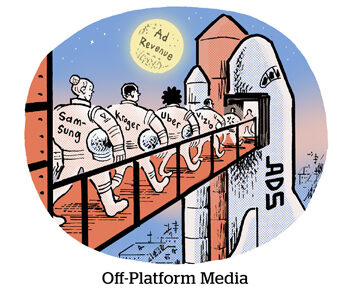Here’s today’s AdExchanger.com news round-up… Want it by email? Sign up here.
Lyft Off
The latest non-advertising company to launch an ad business comes as no surprise.
Ride-hailing app Lyft has introduced Lyft Media, to be helmed by Kenan Saleh, co-founder and former CEO of Halo Cars. Halo, a startup that places digital billboards on rideshare cars, was acquired by Lyft in 2019.
Lyft Media will serve ads to screens on top of cars, to tablets inside cars, alongside bike-charging stations – Lyft operates the NYC and San Francisco bike-share programs – as well as within the main app, of course, The Wall Street Journal reports.
Rather than being targeted to specific individuals, Lyft Media inventory will be targeted based on time and location, according to Saleh, and an undisclosed share of ad revenue will go to drivers.
Lyft has already dabbled in advertising. (It bought Halo three years ago, after all.) But the category has heated up since then.
Last September, Uber hired Mark Grether, former director of Amazon Advertising and former CEO of Sizmek, as GM of its new ad business. In January, T-Mobile acquired Octopus Interactive, which places ads on tablets in ride-share vehicles.
And Volta, an electric car charging station manufacturer, made advertising an important part of its value proposition, including across mobile, out-of-home and retail media. Makes sense, since grocers can set up Volta charging stations in their parking lots.
Measure Up
When it comes to Nielsen measurement alternatives, the TV ad industry has been stuck in will-they-won’t-they mode. New ratings players were all the rage in 2021 and into this year, but didn’t manage to pull all that much upfront spending away from Nielsen.
Adoption, however, is starting to grow, despite predictions that alt currencies wouldn’t be viable until next year’s upfronts.
The majority – 85% – of respondents to a recent VAB Measurement Innovation Task Force survey, say they’ve increased the number of measurement providers they use. And more than a quarter of TV networks say that between 25% and 49% of upfront advertisers now use or are testing measurement alternatives.
The VAB’s report claims to cover programmers that account for 90% of all TV ad spend.
“These results reveal an ad marketplace embracing newer measurement options with escalating urgency,” VAB CEO Sean Cunningham said in a release.
Considering that TV publishers are becoming more reliant on streaming services and non-linear ad buys, the quickening pace away from Nielsen makes sense.
K Street Over Wall Street
Axios, a 5-year-old Washington, DC-based news startup, was sold to Cox Enterprises for $525 million, The New York Times reports.
Cox was already a minority owner, having invested in Axios last year at a $430 million valuation.
The favorable valuation for Axios comes at a time of marked pessimism in the market.
A portfolio of big-name digital news companies attempted to SPAC their way onto the stock exchange without great success. BuzzFeed’s listing last December was so painful that it put the kibosh on potential SPAC plans for Vice, Vox and Bustle Digital, which owns Mic, Gawker and Elite Daily, among other titles.
Digital publishers will be happy with a new benchmark to point to in the form of Axios. BuzzFeed earned $400 million in 2021, and its market cap right now is about $265 million. Axios, on the other hand, was sold for five times its $100 million revenue run rate.
Bustle Digital CEO Bryan Goldberg said he bought a “f**k-ton” of BuzzFeed stock at $6 per share in the hopes that it would reach a 4x revenue multiple, thus improving Bustle’s value by comparison.
TBD on whether that move will pay off. Right now, though, BuzzFeed’s multiple is below 1x, and shares trade for about $2.
But Wait, There’s More!
Google sues Sonos, as the two companies continue their back-and-forth cases over smart speaker IP. [The Verge]
How Apple’s secretive ad tech strategy is shaking up the industry. [Ad Age]
Adam Singer shares best practices that the top digital marketing agencies use to report on digital marketing success. [blog]
Once known for its fast-fashion partnerships, the “Love Island” reality show is forging ahead with eBay as its supplier for “pre-loved” clothing. [Marketing Brew]
You’re Hired!
Steve Teixeira leaves Twitter to become Mozilla’s chief product officer. [tweet]
TripleLift promotes Kama Ostoya to general counsel, succeeding Julia Shullman, former general counsel and chief privacy officer. [release]
Jon Werther returns to Simulmedia as EVP of operations and business development. [release]
Emodo brings on a new CTO and chief customer officer. [release]
Ben Lewis joins Pontiac Intelligence as VP of sales. [LinkedIn]














